The Truth About the MiG-29
How U.S. intelligence services solved the mystery of a cold war killer.
:focal(2143x2938:2144x2939)/https://tf-cmsv2-smithsonianmag-media.s3.amazonaws.com/filer/06/39/06391f6a-7630-44f8-b3a8-551dfa53711b/02za_sep2014_img_6245_live.jpg)
The MiG-29 Fulcrum outside the National Air and Space Intelligence Center at Ohio’s Wright-Patterson Air Force Base has a hornet’s nest growing in its nose. Its tires, lifted off the ground by stands, are split and shredded. Bird droppings drool off its radome. The aircraft gives the impression of a war prize displayed like a head on a stake. In a way, it is a war prize, taken in the winning of the cold war. It’s one of 17 MiG-29s the U.S. government purchased from the former Soviet state of Moldova in 1997, a deal that kept the jets from being sold to Iran. The loose confederation that replaced the Soviet Union was not in a position to stop the buy, and it became one more ignominy in the Soviet collapse. “Any military establishment of any country would be upset if its opponent would receive an opportunity to evaluate and test its most modern weapons,” says Moscow-based aviation historian Sergey Isaev. “I wonder how happy would the White House be and Pentagon if Mexico, for example, would even try to sell its UH-60L Blackhawk helicopters to the Russian Federation?”
The acquisition also gave Western analysts, some of them working inside the grim edifice of this national intelligence center, a chance to study the fighter that they had been viewing from afar for 20 years. When it first showed up, in 1977, the MiG-29, like its very distant ancestor, the MiG-15, was a startling revelation: The Soviets were catching up with U.S. aeronautical technology.
The U.S. intelligence community first learned of the new Soviet aircraft from satellite photos in November 1977, about the time of the jet’s first flight. “Simply by looking at the size and the shape of it, it was clear that the Soviets were developing a counterpart to our F-16 and F/A-18,” says Benjamin Lambeth, author of the 1999 book Russia’s Air Power in Crisis and, in the late 1970s, a defense analyst at the RAND Corporation in Santa Monica, California. “From all the various intelligence sources and methods that we had for gathering electronic and other information, the U.S. government learned a fair amount about the airplane early on, and it was clear we had to do something.” What the Air Force did was to begin development of stealth technology and electronic systems that could hunt and target multiple aircraft at once; in 1981, it issued its first formal requirement for the next generation of fighter technology, an Advanced Tactical Fighter, which eventually became the F-22 Raptor.
In the years since, the bits and bytes first assembled about the MiG-29 have resolved into a much clearer picture, in part because of the opportunity to examine the 21 Moldovan MiGs. Between October 20 and 27, 1997, the Fulcrums—14 frontline C models, six older A’s, and a single B two-seater—were disassembled in Moldova and the parts flown by C-17s to the national intelligence center in Dayton, where they were analyzed by the organization’s foreign materiel exploitation facility. What happened after that, NASIC isn’t saying. NASIC communications officer James Lunsford says, “We don’t want our adversaries to know what we know.” A few Fulcrums that could be made flyable probably went to Edwards Air Force Base in California for testing. At least one example found its way to Nevada’s Nellis Air Force Base Threat Training Facility, known within the service as the Petting Zoo. It displays a host of foreign-made hardware for budding intelligence professionals to examine. As for the rest of the airframes and associated parts: classified, except for one early A model that took the 10-minute trip from NASIC to the National Museum of the U.S. Air Force.
Inside the museum, curator Jeff Duford and I enter the 40,000-square-foot Cold War gallery, and he points out the “Checkpoint Charlie” exhibit. The very recently acquired (and-now-where-do-we-put-it?) NASA Space Shuttle Crew Compartment Trainer dominates the left of the hangar and has pushed the other aircraft into a theme-be-damned hodgepodge to the right. Here, Ohio’s second MiG-29 sits in an illogical 45-degree nose-to-nose pairing with an unlovely Fairchild-Republic A-10 “Warthog.”
Duford lifts the strap on a barrier so we can take a closer look. Unlike the Fulcrum moldering outside NASIC, this example has been beautifully restored and rests in climate-controlled comfort, basking under klieg lights, resplendent in a freshly applied paint job that feels satiny to the touch.
Let’s face it: Soviet jets are ugly, and MiGs are some of the worst offenders. The Vietnam-era MiG-17 and MiG-19 represented a utilitarian tube-with-wings-on-it trend; they were followed by the deadly MiG‑21, a rational sculpture of angles and cone. This one is different. The fluidly beautiful MiG-29 looks like its larger twin-tail contemporary, the slab-sided F-15 Eagle, to the degree that a Bolshoi ballerina resembles a roller derby star. Once the gallery is complete, the two air superiority icons will be exhibited together, Duford says, or the Fulcrum may pose with a more lithe rival, the F-16. Behind the scenes, he and his fellow curators are penciling the floor plan that will showcase the Fulcrum as the worthy adversary it is.
“We’re really fortunate to have this airframe,” Duford says, running his hand over the MiG-29’s right intake. “When we got it, it had Moldovan air force paint on it. It was done very crudely. When the restoration staff sanded in this area, they expected to find bort numbers [the equivalent of an Air Force serial number]. As they sanded, the outline of ‘08’ came through.”
What the numbers revealed, Duford realized, was that this MiG was not only one of the first operational Fulcrums, part of the fighter’s first posting to Moscow’s Kubinka Air Base, but also one of the first displayed outside the Soviet Union. “Some other clues helped reveal [its] provenance,” Duford says. “The gun blast plates…. There are only six openings, which is an indicator it is an early aircraft.” Other evidence came from how the numbers were painted. Unlike on a U.S. Air Force aircraft, where painted numbers are governed by down-to-the-millimeter specs, “on Russian aircraft, the spacing between the numbers can vary,” says Duford. He pored over the photos of a MiG-29 taken at the 1986 airshow at Kuoppio-Rissala, Finland. “It’s like a fingerprint. Looking at the spacing of the numbers and their location, there was no question” that the MiG had been on display in Kuoppio-Rissala.
In 1986, Jukka Hoffren was a Finnish air force photographer assigned to the air base at Tikkakoski, home of the Finnish Air Force Academy. Fascinated by the new MiG, he traveled to Kuoppio-Rissala for the Fulcrum’s international debut. Before 1986, non-Soviets had seen the fighter only in grainy satellite shots published in Aviation Week & Space Technology. “The whole airshow was erected around the MiG-29,” Hoffren told me via email. The Soviets were interested in marketing their new jet to the Finnish air force, which operated a diverse fleet, created by the complex, treaty-driven politics of post-war Finland: the Soviet MiG-21bis, the Swedish Saab Draken, and the British Aerospace Hawk. Compared to the capable MiG-21, which was built in Tblisi, Georgia, in a mode of construction that could best be described as “finalized by hammer,” Hoffren says, the new MiG was startling. “As one can describe the MiG-21 as a ‘rocket that has wings,’ the MiG-29 was really an agile dogfighter, and it seemed easily a match, or could even outfly, the F-16.”
Seeing the real thing, as Hoffren had in Finland, is more informative than seeing pictures, but you can’t really know an airplane until you fly it, and in December 1989, Ben Lambeth got his chance. At Kubinka Air Base on December 15, in dreary skies, Lambeth became the first Western analyst to fly a MiG-29 and the first Westerner invited to fly a combat aircraft inside Soviet airspace since the end of World War II. (A Canadian air force fighter pilot flew the MiG at the August 1989 Abbotsford Air Show.)
Two years after its Kuoppio-Rissala debut, the Soviets showcased the Fulcrum at the 1988 Farnborough Airshow in England, and a year later at the 1989 Paris Air Show. At the time, Lambeth was a senior analyst at RAND. He had served as a Soviet military specialist at the Central Intelligence Agency, and he was a civilian pilot whose work at RAND on tactical air warfare for the Air Force had provided him the opportunity to fly a number of high-performance jets. At Farnborough, he met Mikoyan Design Bureau chief test pilot Valery Menitsky, who was accompanying an entourage of pilots, technicians, and support personnel for the Fulcrum’s first major Western exhibition. A friendship developed.
“I had been writing about Soviet aircraft for years,” Lambeth says. “When I heard the MiG-29 was coming to Farnborough, I couldn’t believe it. And I never anticipated I would have the good fortune to fly it. It was a kind of cold war drama—a guy who had worked at the CIA getting to fly a Soviet jet with a red star on it.” Lambeth told Menitsky that he’d like to fly the MiG-29. “Instead of falling out of his chair with laughter, he said that might possibly happen.” Lambeth’s timing was good: Soviet premier Mikhail Gorbachev had recently introduced glasnost, and, because the Soviets were hoping to sell the new fighter to other governments, they were open to new ways of showcasing its capabilities.
The weather in Kubinka that winter was nasty, so for the flight, in a MiG-29UB, Menitsky took the front seat, and Lambeth climbed into the rear. His flight included a series of maneuvers Lambeth had just happened to have flown in a Hawaii Air National Guard F-15 at Hickam Air Force Base, Honolulu, only a few weeks earlier. Lambeth’s RAND report, published in 1990, was the first unclassified assessment of the formerly mysterious fighter. Although he was careful to point out that he had no training as a test pilot, or as a fighter pilot, Lambeth’s report does describe the experience of the MiG-29 from the cockpit.
Soon, the West would learn all about the Fulcrum—by operating it. Three months before Lambeth’s flight, about 7,000 East German refugees traveled to Hungary on tourist visas and camped outside Budapest. On September 10, 1989, Hungary formally opened its border with Austria, allowing the refugees access to West Germany. By 1990, Germany was reunified—and on the day after Christmas 1991, the Soviet Union would vote itself out of existence.
The MiG-29 was the only combat aircraft the unified German government retained from the former East German force. “The Germans were invaluable,” says NASIC historian Rob Young. “The Germans taught us more about the MiG-29 [than we could have otherwise derived]. We had majors and lieutenant colonels in an exchange program. It’s similar to the MiG-15, in that we were looking at modeling and simulations, and developed threat assessments long before we got our hands on one.” During the Korean War, NASIC’s predecessor, the Air Technical Intelligence Center, recovered parts of crashed MiG-15s and studied the wreckage to learn more about that game-changing MiG’s performance. U.S. Air Force test pilots were able to fly one after a North Korean pilot defected in September 1953 (see “The Jet that Shocked the West,” Dec. 2013/Jan. 2014).
In 1991, the former East Germany had 29 Fulcrums based at Preschen, near the Polish border. When the Iron Curtain fell, West German pilots and technicians began to evaluate their former adversaries to determine if they could be integrated into the new German air force—and ultimately began a training program with former East German Nationale Volksarmee (NVA) pilots as instructors.
The best of the young West German lieutenants and captains were recruited to convert to the MiG. In the years to come, Jagdgeschwader (Fighter Wing) 73, which relocated to Laage, near the Baltic coast, would be deluged with requests from Western air forces and navies clamoring to fly against the Fulcrum.
Peter “Stoini” Steiniger was a former West German fighter pilot and graduate of the prestigious Euro-NATO Joint Jet Pilot Training at Sheppard Air Force Base, Texas. Returning to Germany, he flew the F-4F, an export version of the legendary McDonnell Douglas Phantom, which would continue in German service until 2013. As a lieutenant in 1986, he and his fellow pilots had been shown satellite photos of a sobering new Soviet design. A scant five years after reunification, he was living a surreal twist of history: He was not only a mission-ready Fulcrum pilot, but also JG 73’s operations officer, busy coordinating exchange visits. “For example,” Steiniger says, “I would pair this young, pumped-up, and all-excited F-16 pilot with an ‘original’ NVA equivalent to go out and fight one-on-one neutral [basic fighter maneuvers]. We had hundreds of missions like this, with thousands of lessons learned in debriefings with our counterpart [in Western aircraft] hanging on our words and staring at our video tape…most of the time in astonishment.”
Plenty of the Fulcrum’s smug “show us what you got” adversaries—F-16 Fighting Falcon, F-15 Eagle, and U.S. Navy F-14 Tomcat and F/A-18 Hornet jocks among them—became humbled, and often bloodied, after their first Fulcrum tangle. “With some experience, you could outmaneuver any jet, even Vipers [F-16s]and [high-angle-of-attack] Hornets,” says Steiniger. “The nice airframe in combination with one weapon was the killer: The Archer in [sensor lock] mode.” Introduced in the mid-1980s, the Archer AA-11 is a very capable heat-seeker with a greater range than the U.S. Sidewinder. “A simple monocular lens in front of my right eye enabled me to slew the seeker head of the missile onto my adversary at high angle off [target].” The Fulcrum’s ability to lock a missile even though its nose was pointed far away from its target “watered many eyes,” says Steiniger.
As good as the Fulcrum was in a knife fight, most Western pilots soon discovered its flaws. Mike Jaensch, a former F-16 pilot and Air Force Weapons School graduate with a background in air defense, returned to active duty in 1994 after being furloughed from American Airlines. Fluent in German, he won a spot in a small group of exchange pilots posted to Laage in 1998 with a combined MiG squadron. Jaensch loved the MiG’s power and maneuverability, but felt hampered by its radar and associated systems. “The Soviet philosophy was that basically pilots were stick actuators,” he says. “It was obviously very different from what we were used to. The avionics were marginal. That same philosophy meant [the Soviets] didn’t see the need to pass information on to the pilot.” Since the MiG’s systems couldn’t convey a complex battlespace to the pilot, combat deployments were vetoed. In 1998, NATO forces had considered dispatching the Laage MiGs to Kosovo but scrapped the idea. The Airborne Warning and Control System operators would have had to offer the MiGs special handling. “With AWACS calling out [information] to three to six combat air patrols, they’d have to give us extra information,” Jaensch says. “We decided we’d get more in the way than help.” In addition, the Serbs also flew Fulcrums, making identification in the air difficult.
In 1996, Fred “Spanky” Clifton became the first American MiG-29 exchange pilot with JG 73. A Weapons School graudate in the F-16, with thousands of hours in F-15s, F-5s, and MiG-29s as well, he turns an analyst’s cold eye on the Fulcrum. “It’s a great [basic fighter maneuvers] machine,” he says. “But of the four fighters, it’s easily the worst-handling of any I flew.” Before becoming a Fulcrum driver, Clifton had his first pilot-scholar assignment as an aggressor, flying F-5 Tigers in intensive training aimed at honing the skills of experienced pilots against known threats, including the MiG-29. When he joined JG 73, it was a unique opportunity to judge the Stateside syllabus. “I got to see if what I was teaching as an aggressor pilot was correct,” he says. “Much of what we ascertained through intelligence was indeed accurate.” Yes, the Fulcrum was a highly capable dogfighter, and its ability to fire a shot regardless of where the nose was pointed was impressive. (The Russians lost the aiming advantage by 2002, according to Fred Clifton, when the U.S. military fielded the AIM-9X missile and the Joint Helmet-mounted Cueing System.) But it had low fuel capacity, a head-down, knob- and switch-congested cockpit, a so-so radar, and not much versatility: It wasn’t designed to do much besides intercept and shoot down adversaries who were flying not far from its airfield. Eastern bloc pilots were trained to slavishly follow ground controllers, so the Fulcrum’s systems, including its head-up display, were not highly developed, and the situational awareness the pilots got was very limited.
Doug Russell, an airline pilot who flew exchange with JG 73 and today occasionally flies a civilian-registered MiG-29 obtained from Kyrgyzstan and owned by Microsoft co-founder Paul Allen (Clifton sometimes flies the other U.S.-registered Fulcrum, which is owned by Air USA in Illinois), loved his time in the jet, but says it was like a weekend in Vegas—heavy on hedonism, with little redeeming value. “We stood alert with live ordnance, but we weren’t going anywhere,” he says of his time with the Luftwaffe. “It was hard as a Western guy to fly it because you didn’t have the level of awareness…. We would never be invited to the dance.” Russell believes that NATO analysts were very interested in the MiG and pressured the German government to keep flying it.
Shortly after Clifton arrived at JG 73, he learned that technical analysis in the United States would soon reveal the Fulcrum’s remaining secrets. On a trip to Ramstein Air Base, he had attended a classified briefing on the U.S. Air Force purchase of the Moldovan MiGs. It was widely assumed that the Air Force would launch an aggressor squadron of MiG‑29s, but only a few of the purchased airframes were airworthy, and the cost of getting the rest into the air—not to mention the embarrassment of having to bargain with the Russian Federation for parts—made an aggressor squadron impractical.
Peter Steiniger runs a website that enthusiastically chronicles the German MiG experience, and is replete with stunning photos and heartfelt tributes to the Fulcrum. And yet Steiniger says: “Would I want to go to war with it? No. Except for the [AA-11 Archer system], the cockpit was terribly labor-intensive. Our overall [situational awareness in beyond visual range] setups was in the map case.” In other words, the pilot had to put his head down, break out the paper, and figure out where he was.
Although a small number of Fulcrums continue to be upgraded—Poland’s MiGs are receiving new mission computers, navigation technology, and even a Rockwell Collins UHF/VHF radio—other air forces, except for an inordinate number of former Soviet-aligned states, never queued up to buy the Fulcrum after the cold war. “The MiG-29 really got exposed with the fall of the Iron Curtain,” Clifton says. “You don’t see further foreign sales. Who’s bought it? Nobody.” As to the wisdom of upgrading the Fulcrum into a modern, data-linked, multi-role fighter, Clifton says, “Go buy an F-16. It would be more economical, and it’s a better airplane.”
Today the Russians are offering for export a better MiG, the -35. “Over the years, the Russians modified the MiG-29. They tweaked it, improved it,” says Ben Lambeth. “The MiG-35 looks like a MiG-29, but it has much more capability.” So far it has attracted only one potential customer: India. The new jet will reportedly join the Russian air force in 2016. But the attention of Western analysts—and almost certainly the syllabus of the Air Force Weapons School—is now focused on the products of a different aviation design bureau.
In 2010, the Russians flew a counterpart to the F-22 Raptor. Designed by Sukhoi and descended from the Su-27, the Sukhoi T-50 is a multi-role fighter that may have electronics to rival the F-22’s. According to Lambeth, it will still lag 10 years behind the Raptor. “One widespread suspicion is that it will not be as stealthy,” he says. “There are too many features on it that appear radar-significant.” But it’s difficult from this distance to judge how the T-50 will perform, or even whether Russia will continue its development. It’s the new mystery, and no Westerner will be invited any time soon to take it for a spin.
/https://tf-cmsv2-smithsonianmag-media.s3.amazonaws.com/accounts/headshot/Sotham_photo.jpg)
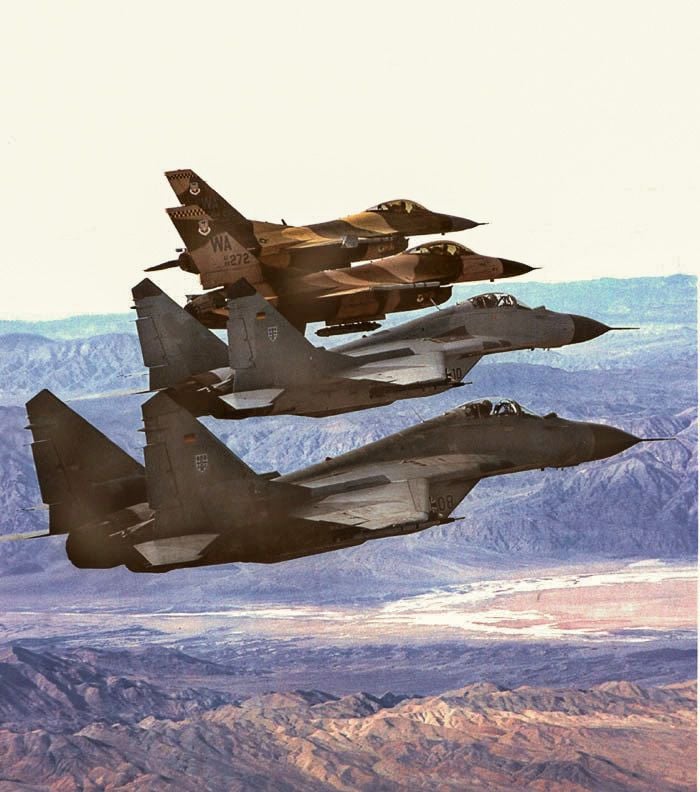
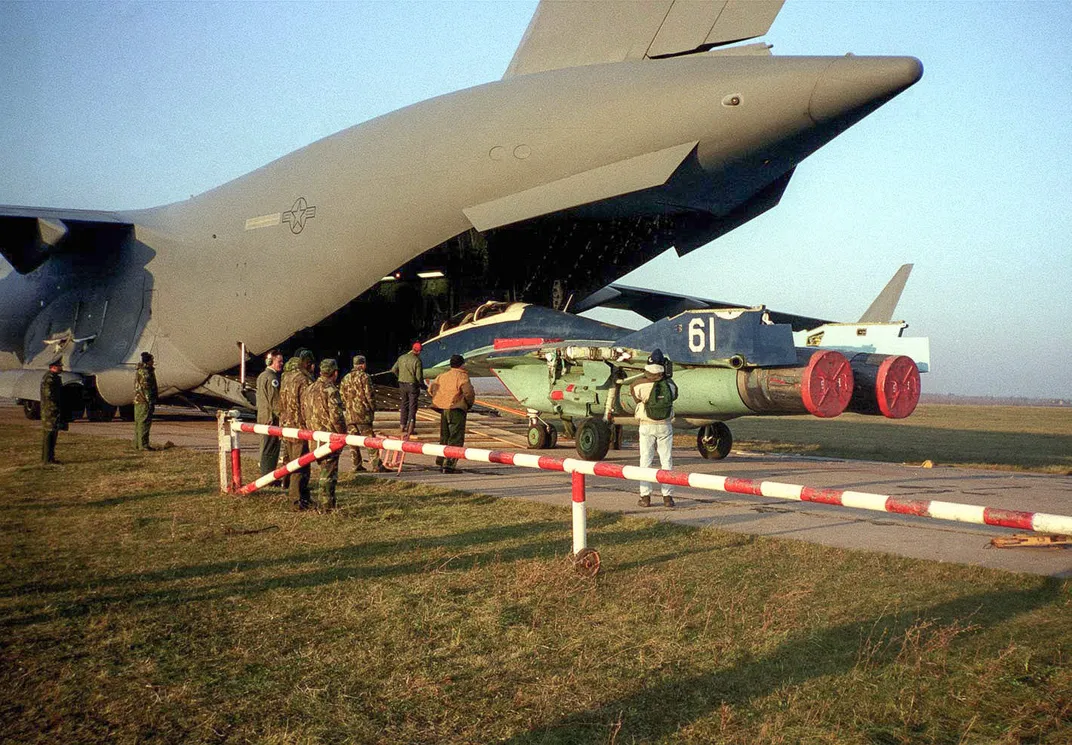
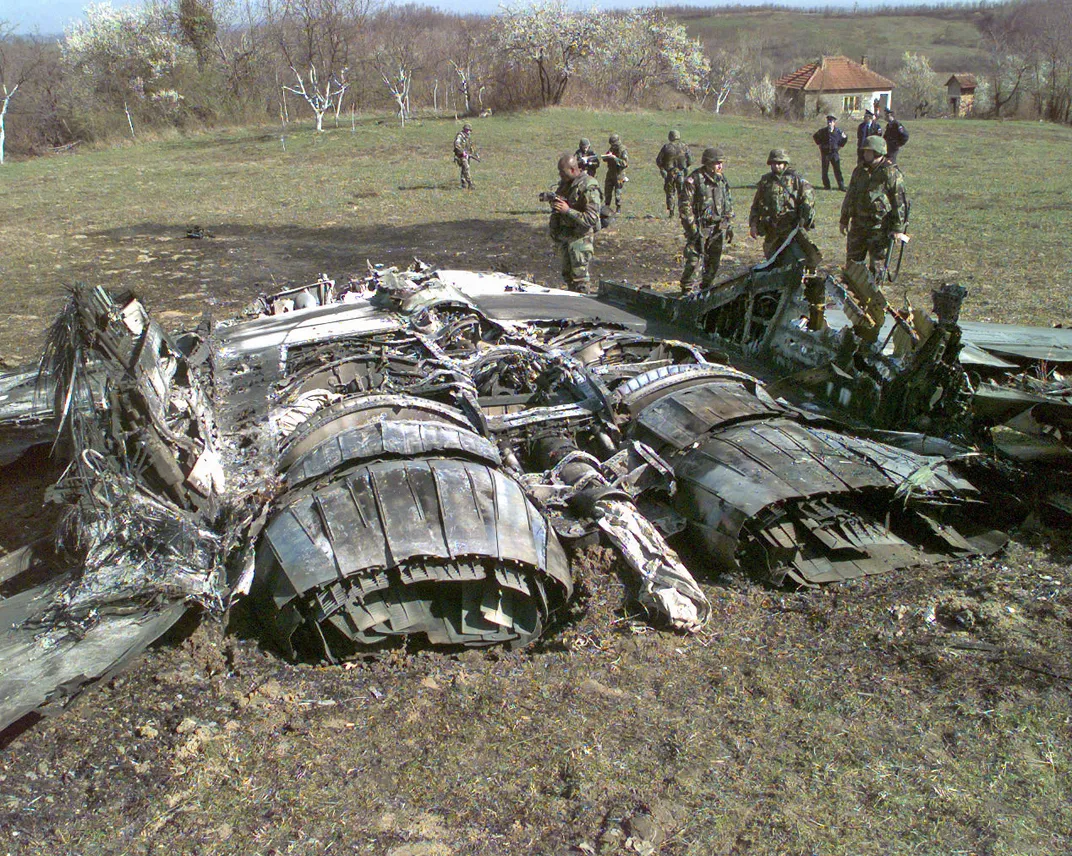
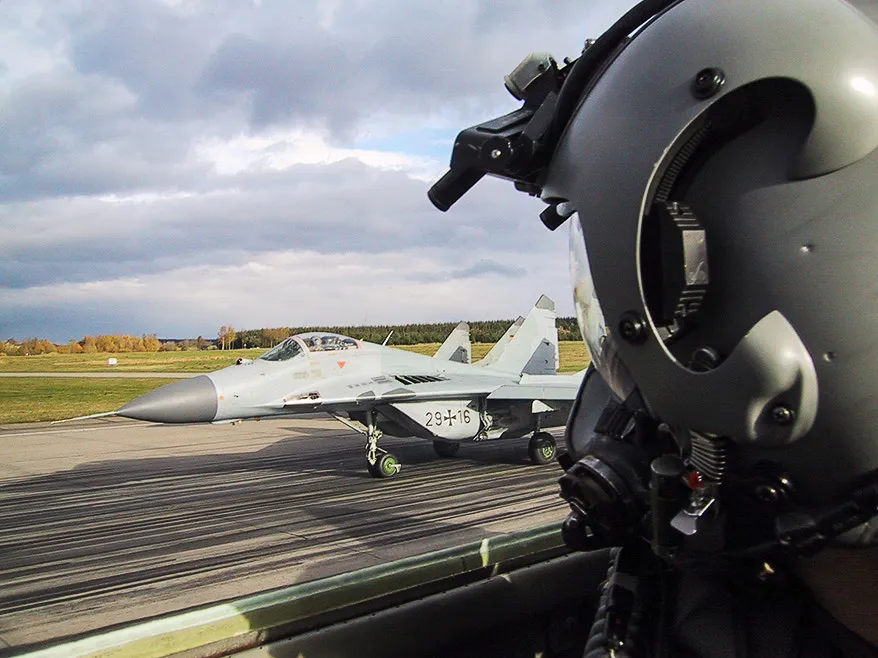
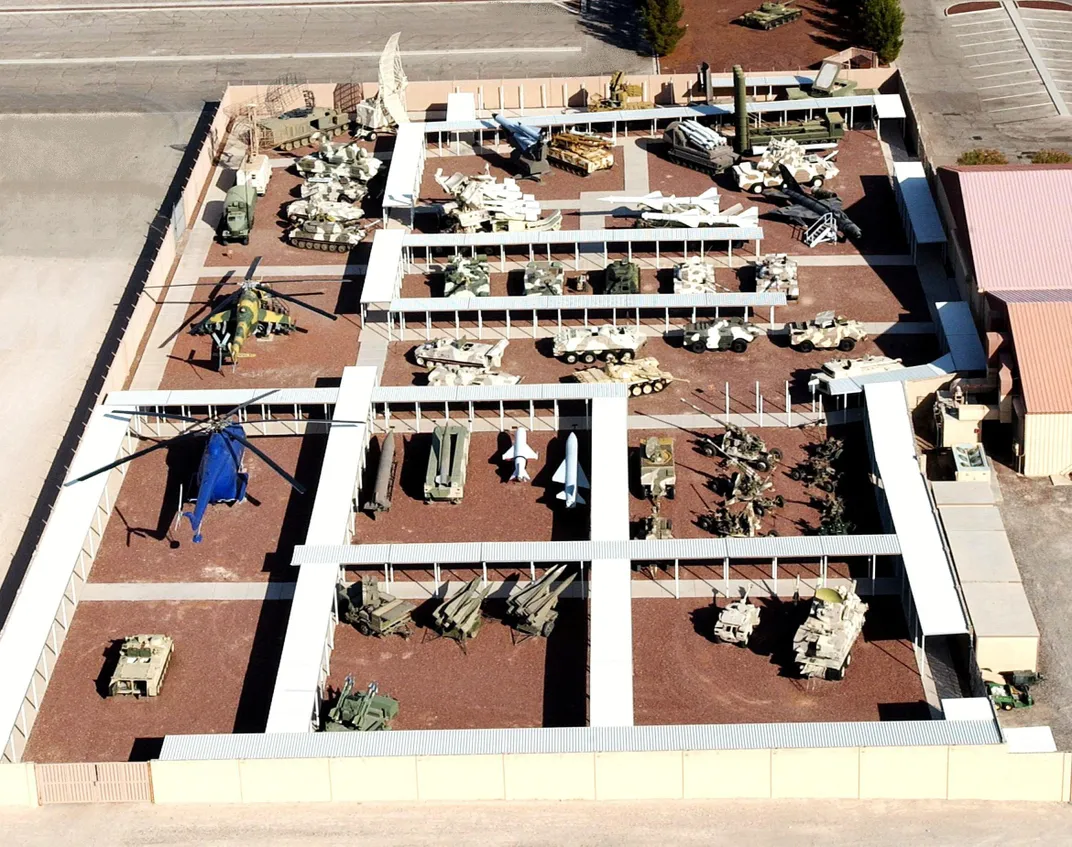

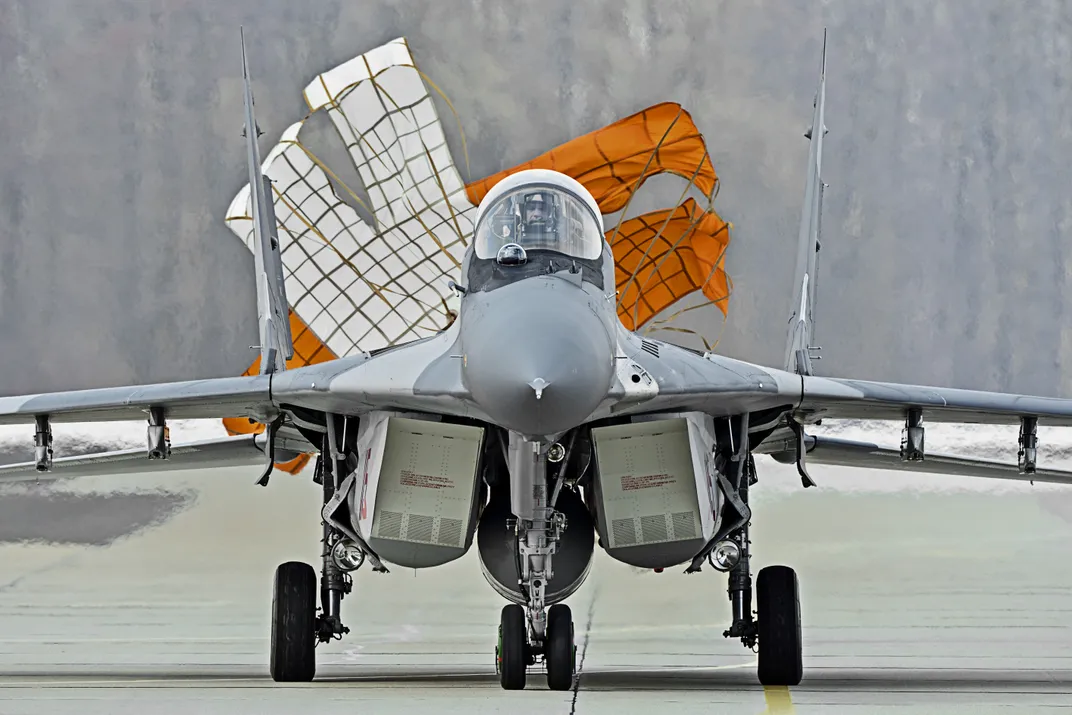
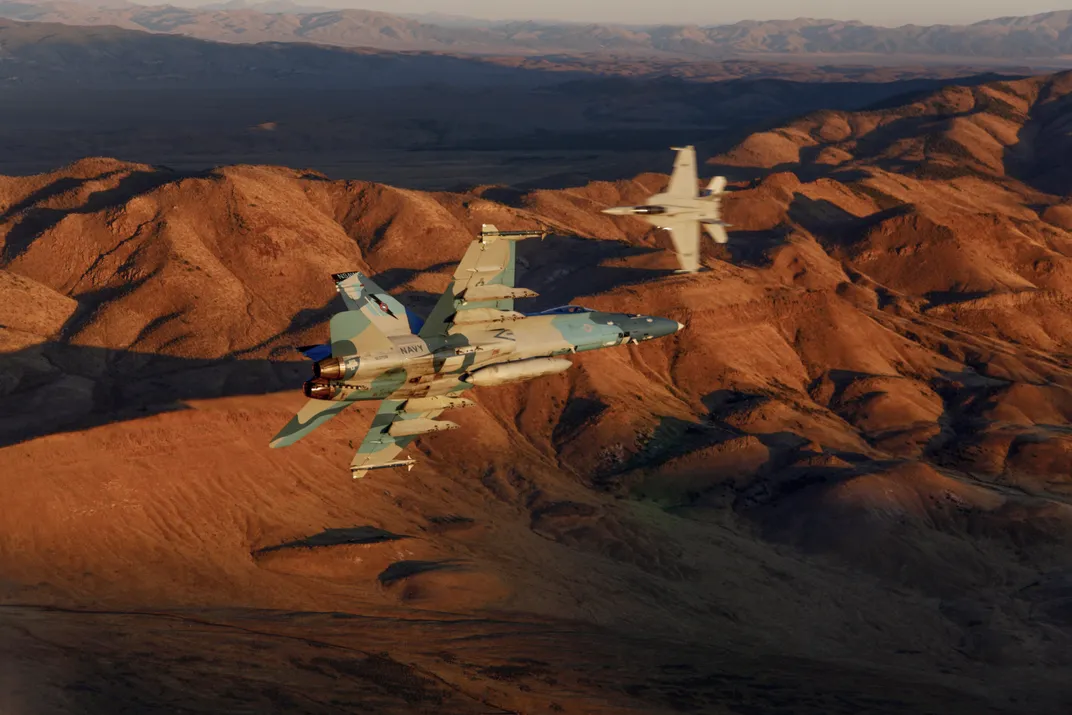
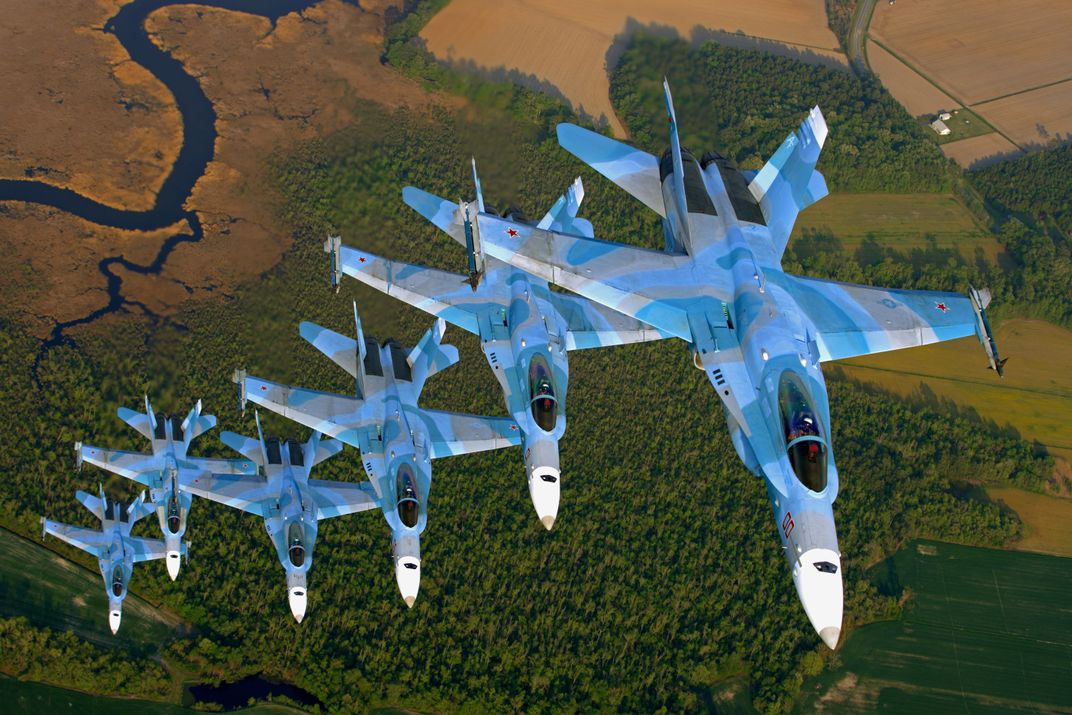
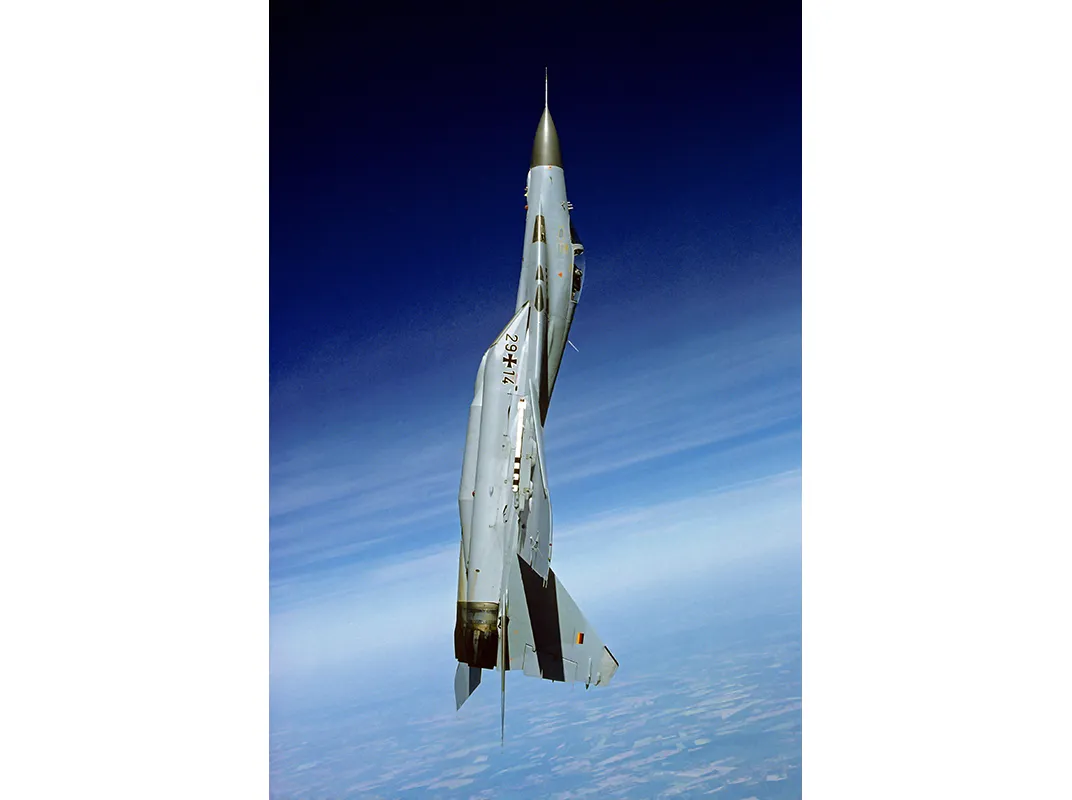
/https://tf-cmsv2-smithsonianmag-media.s3.amazonaws.com/accounts/headshot/Sotham_photo.jpg)